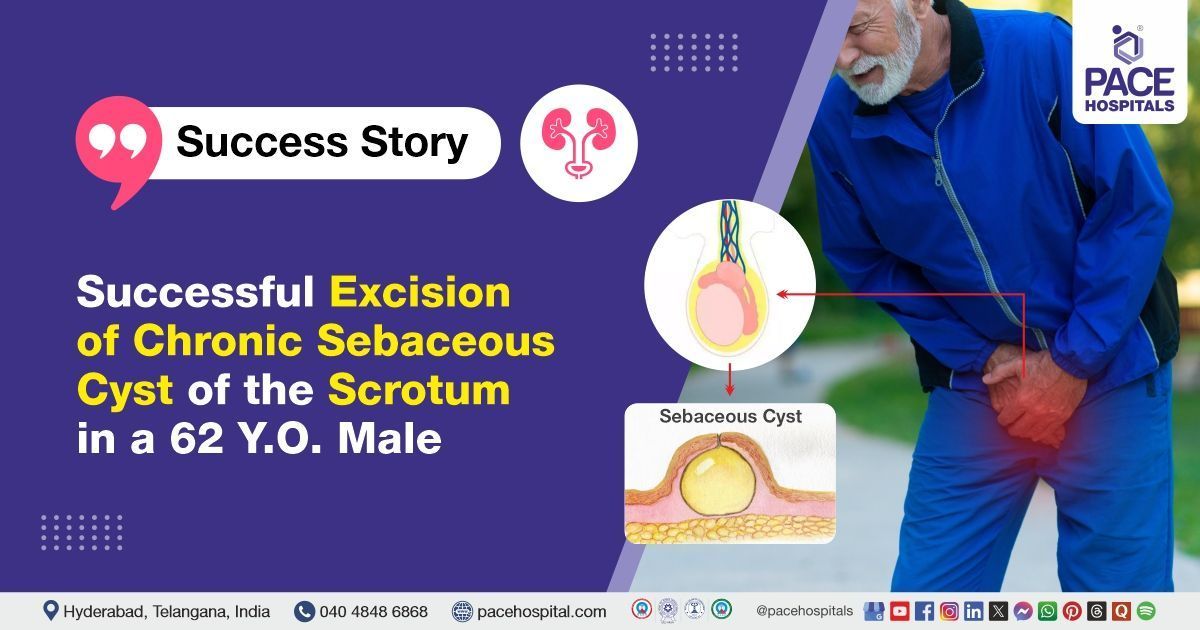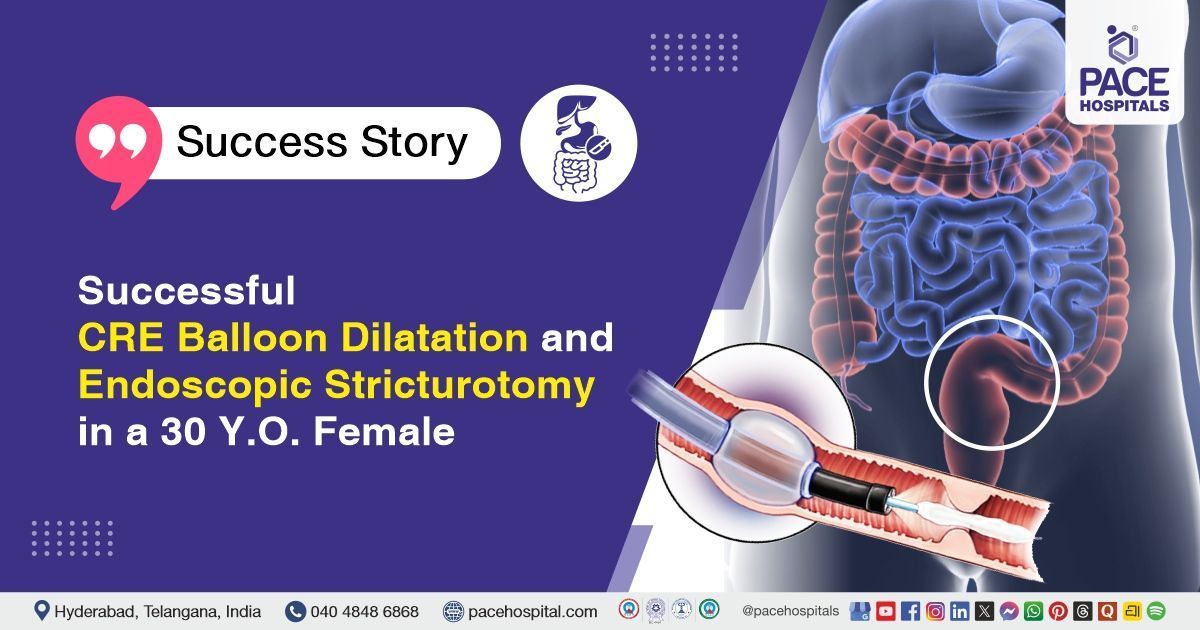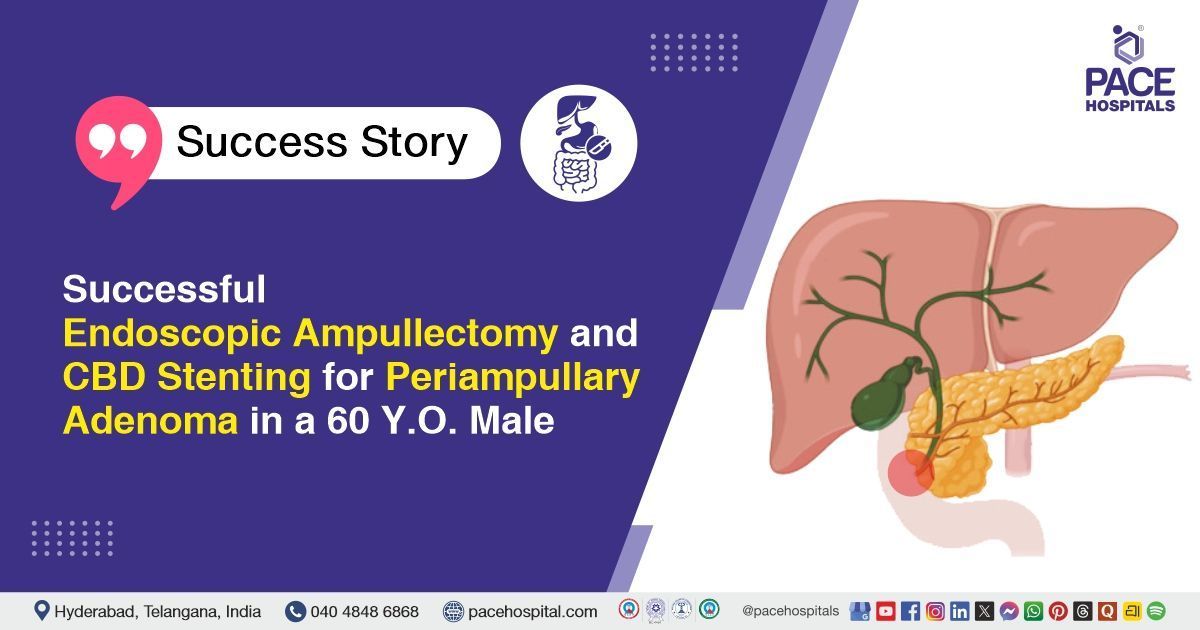Successful Excision of Chronic Sebaceous Cyst of the Scrotum in a 62 Y.O. Male
PACE Hospitals
The PACE Hospital's expert Urology team successfully performed a Left Scrotal Sebaceous Cyst Excision on a 62-year-old male patient diagnosed with a left large (15 cm) sebaceous cyst of the scrotum. The aim of the procedure was to remove the long-standing cyst to reduce discomfort, prevent further complications such as infection or rupture, and to confirm the benign nature of the lesion through histopathological examination.
Chief Complaints
A 62-year-old male patient with a
body mass index (BMI) of 21.2 presented to the Urology Department at
PACE Hospitals, Hitech City, Hyderabad, with complaints of left scrotal swelling persisting for the past 20 years. A comprehensive evaluation was undertaken to determine the underlying cause of his symptoms.
Past Medical History
The patient had a history of Diabetes Mellitus (DM), which was well-managed with medication and diet. He also had a history of Vocal Cord Palsy, likely contributing to voice changes and requiring careful airway assessment during anesthesia.
On Examination
On examination, the patient was conscious, coherent, and oriented, with stable vital signs. Local examination revealed a single, well-defined, non-tender swelling approximately 15 cm in diameter on the left side of the scrotum. The swelling was soft to firm in consistency, had limited mobility, and the overlying skin was stretched but intact. It was non-transilluminate, non-reducible, and showed no cough impulse. These clinical features were consistent with a sebaceous cyst, and no signs of infection or malignancy were observed. Airway evaluation was done in view of the history of vocal cord palsy. No signs of active diabetic complications were noted.
Diagnosis
Upon admission to PACE Hospitals, the patient was thoroughly evaluated by the Urology team, including a detailed review of his medical history and a comprehensive clinical examination. Presented with a longstanding left scrotal swelling, there was a strong clinical suspicion of a large sebaceous cyst of the scrotum.
Physical examination revealed a well-defined, non-transilluminant, non-reducible swelling approximately 15 cm in size on the left scrotum, consistent with a sebaceous cyst.
Laboratory investigations showed stable vital signs, normal renal function, and blood sugar levels indicating controlled diabetes mellitus. The coagulation profile was slightly abnormal with an elevated INR. Viral screening for HIV, Hepatitis B, and Hepatitis C was normal. Chest X-ray showed mild abnormal changes in the right lower lung with otherwise normal heart size and lung fields.
Based on clinical and laboratory findings, the patient was advised to undergo
Left Large Sebaceous Cyst Scrotum Treatment in Hyderabad, India, under the expert care of the Urology Department.
Medical Decision Making
After a detailed consultation with Dr. K Ravichandra, Consultant Laparoscopic Urologist, along with a cross consultation from Dr. Pradeep Kiran Panchadi, Consultant Pulmonologist, in view of vocal cord palsy, a comprehensive evaluation was conducted focusing on the patient’s longstanding left scrotal swelling and associated medical conditions. Clinical and investigative findings confirmed the presence of a large sebaceous cyst on the left scrotum, with no evidence of infection or malignancy.
It was determined that the patient had a large sebaceous cyst responsible for the longstanding left scrotal swelling. Left scrotal sebaceous cyst excision under spinal anesthesia was identified as the most appropriate intervention to relieve the patient’s symptoms, prevent potential complications such as infection or rupture, and improve quality of life. The patient’s coexisting conditions, including diabetes mellitus and vocal cord palsy, were also considered in planning perioperative care.
The patient and his family members were informed about the diagnosis of a large left sebaceous cyst of the scrotum, the planned surgical excision, the associated risks, and the expected benefits aimed at symptom relief and prevention of further complications.
Surgical Procedure
Following the decision, the patient was scheduled for Left Scrotal Sebaceous Cyst Excision Surgery in Hyderabad at PACE Hospitals, under the expert care of the urology department.
The procedure involved the following steps:
- Preoperative Preparation: Before the surgery, the patient underwent a complete preoperative assessment including blood tests, chest X-ray, and screening for infectious diseases. All values were within acceptable limits for surgery. Informed consent was obtained after explaining the nature of the sebaceous cyst, the surgical procedure, potential risks, and expected benefits. The scrotal area was cleaned, shaved, and prepared under aseptic conditions.
- Anesthesia and Positioning: The procedure was performed under spinal anesthesia. The patient was positioned supine, ensuring adequate exposure of the surgical site. After confirming adequate anesthesia, the area was draped in a sterile fashion, and all aseptic precautions were strictly maintained.
- Surgical Incision and Cyst Excision: A vertical scrotal incision was made directly over the swelling. Dissection was carried down through the skin and subcutaneous tissues. The sebaceous cyst, which was large and well-encapsulated, was identified and carefully dissected from surrounding tissues. The cyst was excised in toto, avoiding rupture, and complete removal of the cyst wall was ensured.
- Hemostasis and Wound Closure: Bleeding was minimal and effectively controlled using electrocautery. The surgical site was irrigated with normal saline. Hemostasis was confirmed, and layered wound closure was performed. The deeper layers were closed using absorbable sutures, and the skin was approximated with interrupted non-absorbable sutures.
- Dressing and Specimen Handling: A sterile dressing was applied to the surgical site. The excised cyst was labelled and sent for histopathological examination to confirm the benign nature of the lesion and to rule out any atypical pathology.
Postoperative Care
The procedure was uneventful, and the patient remained hemodynamically stable in the recovery area. The surgical site was clean with no signs of bleeding or complications. The excised cyst was sent for histopathological analysis. Postoperative medications, including antibiotics and analgesics, were administered. The patient was discharged in stable condition with appropriate follow-up instructions.
Discharge Medications
At the time of discharge, the patient was prescribed medications including antibiotics to prevent postoperative infections, anti-inflammatory agents to manage local inflammation and swelling, and analgesics for pain relief. In addition, his existing antidiabetic medications were continued as part of the ongoing management of diabetes mellitus.
Dietary Advice
Patient was advised to follow a diabetic-friendly diet to help manage blood sugar levels effectively.
Emergency Care
The patient was instructed to contact the emergency ward at PACE Hospitals in case of any emergency or development of symptoms like fever, bleeding.
Review and Follow-up Notes
The patient was advised to return for a follow-up visit with the Urologist in Hyderabad at PACE Hospitals after 3 days for dressing.
Conclusion
This case highlights the successful surgical management of a large sebaceous cyst in the left scrotum through excision under spinal anesthesia. It underscores the importance of thorough clinical evaluation and multidisciplinary care, especially in a patient with comorbidities like diabetes and vocal cord palsy. The patient recovered well with no complications and was discharged in stable condition.
Importance of Timely Intervention and Multidisciplinary Management in Chronic Sebaceous Cysts
Chronic sebaceous cysts that remain untreated for long durations can increase in size, causing discomfort, cosmetic issues, and risks such as infection or rupture. Effective management requires thorough clinical evaluation and a carefully planned surgical excision by a
urologist / urology doctor to ensure complete removal and minimize complications. The coexistence of chronic conditions, such as diabetes mellitus, emphasizes the need for a multidisciplinary approach involving relevant specialties to optimize patient care. Coordinated treatment and timely surgical intervention contribute to better outcomes, faster recovery, and fewer postoperative complications. This underscores the significance of comprehensive patient management in cases involving benign yet potentially problematic lesions.
Share on
Request an appointment
Fill in the appointment form or call us instantly to book a confirmed appointment with our super specialist at 04048486868











